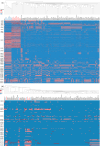High-density SNP genotyping array for hexaploid wheat and its secondary and tertiary gene pool
- PMID: 26466852
- PMCID: PMC4950041
- DOI: 10.1111/pbi.12485
High-density SNP genotyping array for hexaploid wheat and its secondary and tertiary gene pool
Abstract
In wheat, a lack of genetic diversity between breeding lines has been recognized as a significant block to future yield increases. Species belonging to bread wheat's secondary and tertiary gene pools harbour a much greater level of genetic variability, and are an important source of genes to broaden its genetic base. Introgression of novel genes from progenitors and related species has been widely employed to improve the agronomic characteristics of hexaploid wheat, but this approach has been hampered by a lack of markers that can be used to track introduced chromosome segments. Here, we describe the identification of a large number of single nucleotide polymorphisms that can be used to genotype hexaploid wheat and to identify and track introgressions from a variety of sources. We have validated these markers using an ultra-high-density Axiom(®) genotyping array to characterize a range of diploid, tetraploid and hexaploid wheat accessions and wheat relatives. To facilitate the use of these, both the markers and the associated sequence and genotype information have been made available through an interactive web site.
Keywords: genotyping array; next-generation sequencing; secondary and tertiary gene pools; single nucleotide polymorphism; wheat; wheat progenitors.
© 2015 The Authors. Plant Biotechnology Journal published by Society for Experimental Biology and The Association of Applied Biologists and John Wiley & Sons Ltd.
Figures





References
-
- Allen, A.M. , Barker, G.L. , Berry, S.T. , Coghill, J.A. , Gwilliam, R. , Kirby, S. , Robinson, P. et al. (2011) Transcript‐specific, single‐nucleotide polymorphism discovery and linkage analysis in hexaploid bread wheat (Triticum aestivum L.). Plant Biotechnol. J. 9, 1086–1099. - PubMed
-
- Allen, A.M. , Barker, G.L. , Wilkinson, P. , Burridge, A. , Winfield, M. , Coghill, J. , Uauy, C. et al. (2013) Discovery and development of exome‐based, codominant single nucleotide polymorphism markers in hexaploid wheat (Triticum aestivum L.). Plant Biotechnol. J. 11, 279–295. - PubMed
-
- Burt, C. and Nicholson, P. (2011) Exploiting co‐linearity among grass species to map the Aegilops ventricosa‐derived Pch1 eyespot resistance in wheat and establish its relationship to Pch2 . Theor. Appl. Genet. 123, 1387–1400. - PubMed
Publication types
MeSH terms
Substances
Grants and funding
- BB/E006868/1/BB_/Biotechnology and Biological Sciences Research Council/United Kingdom
- BB/L01386X/1/BB_/Biotechnology and Biological Sciences Research Council/United Kingdom
- BB/I017496/1/BB_/Biotechnology and Biological Sciences Research Council/United Kingdom
- BB/I003207/1/BB_/Biotechnology and Biological Sciences Research Council/United Kingdom
LinkOut - more resources
Full Text Sources
Other Literature Sources

